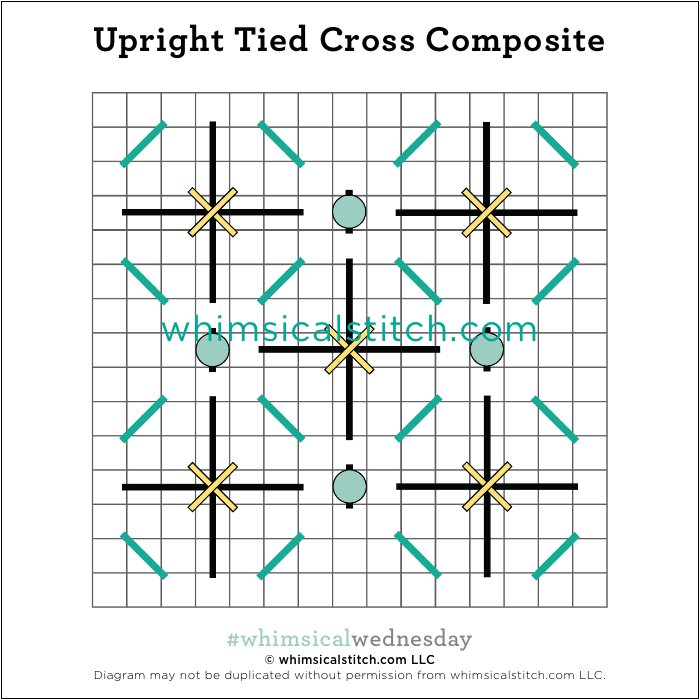The moral of today’s post is to follow that tiny nagging feeling. Let’s just leave it at I was not anticipating sharing a stitch with three threads AND pearls today.
The Upright Tied Crosses in today’s stitch are slightly larger than what I typically think of as Upright Tied Crosses. The bottom stitches (black lines) are six rows long versus the four illustrated in the link. My original plan a stitch with the Upright Crosses (black and aqua lines) and the pearls (aqua circles) only. But I could tell something was missing, so I took some inspiration from Kelly Clark and added the diagonal stitches inside the emerging squares to create a stronger purpose and more definition to the pearls. And voila! The stitched sample uses three plies of Splendor (black lines) with Kreinik 1/16” ribbon on top (yellow lines). The diamonds are created with Shimmer Ribbon (turquoise lines) and SJ Designs 2mm pearls with white beading thread (aqua circles with black lines).
The stitched sample is a very feminine bedspread for an upcoming Stitch Concept. Along those lines, it will make a very pretty dress for a flapper with a simple addition of a contrasting color for the yellow lines and a bead or even a Swarovski crystal for the pearl. I also think it will make a fun toy box with red and silver metallics for the black and yellow lines, red silk floss for the turquoise lines, and bright blue beads for the aqua circles.
Just a reminder about how to evaluate stitches for size on your project.
As you are auditioning stitches (from any stitch source), count the number of canvas threads on the diagram that match your mesh size. And there you have what an inch of the stitch will look like. Evaluate that against the area where you plan to use the stitch and make your final decision. If you start integrating this step into your stitch selection process, you may be surprised at how many stitches you think are large are much smaller than you realize. (Or, in today’s case, the stitch is much larger than it looks.)
By (sometimes) including this step in my own process, I find I am now integrating much longer stitches than I ever thought I would. I used to think a stitch six rows long was super big. I have very much changed my tune, which has helped me expand my creativity, especially for large-space stitches.
Today’s stitch diagram, along with all other #whimsicalwednesday and #smallspacesunday stitch diagrams, can also be found on a Pinterest board here. Be sure to follow whimsicalstitch.com on Facebook, Pinterest, Instagram, and Twitter.
If you like what you see on this blog, there's more. Mary’s Whimsical Stitches is a series of three books offering contemporary how-to collections of more than 250 stitches (in each volume) for all stitchers, regardless of skill level. All books include updated and sequenced diagrams from this blog plus a collection of all-new stitches from private lessons and other class projects. Visit here to find a needlepoint retailer that carries my books.
New to needlepoint or looking for a refresher? Please download a handy how-to guide covering basic needlepoint stitches and stitch compensation techniques along with new top-line information on needlepoint materials and tools, how to handle threads, and other helpful needlepoint resources.
whimsicalstitch.com also sells Stitch Guides and Stitch Concepts for Melissa Shirley Designs, Zecca Designs, Sandra Gilmore, Purple Palm, Maggie, and Penny MacLeod, and many more. Click here to see the newest guides and click here to see the entire collection.
I hope you have the perfect spot for this stitch! Please enjoy! Have a wonderful #whimsicalwednesday!
A Note about Diagrams
I use color in diagrams to make them as clear as possible. The primary function of different colored lines is to illustrate a stitch sequence. For example, the layering of colors demonstrates you add them in that order. They can also provide ideas on integrating additional threads (one line for each color). Or, you can use the same thread for all color lines. That's where I encourage you to use your imagination for the space you are stitching!




